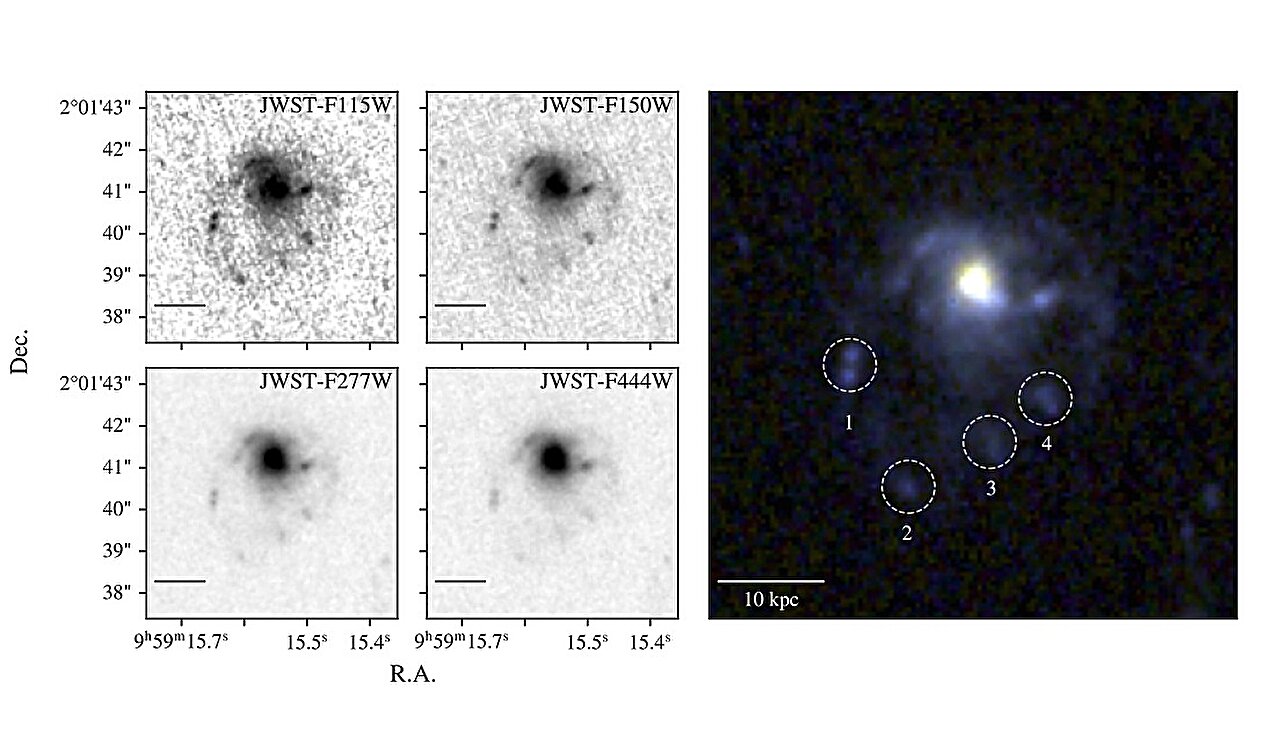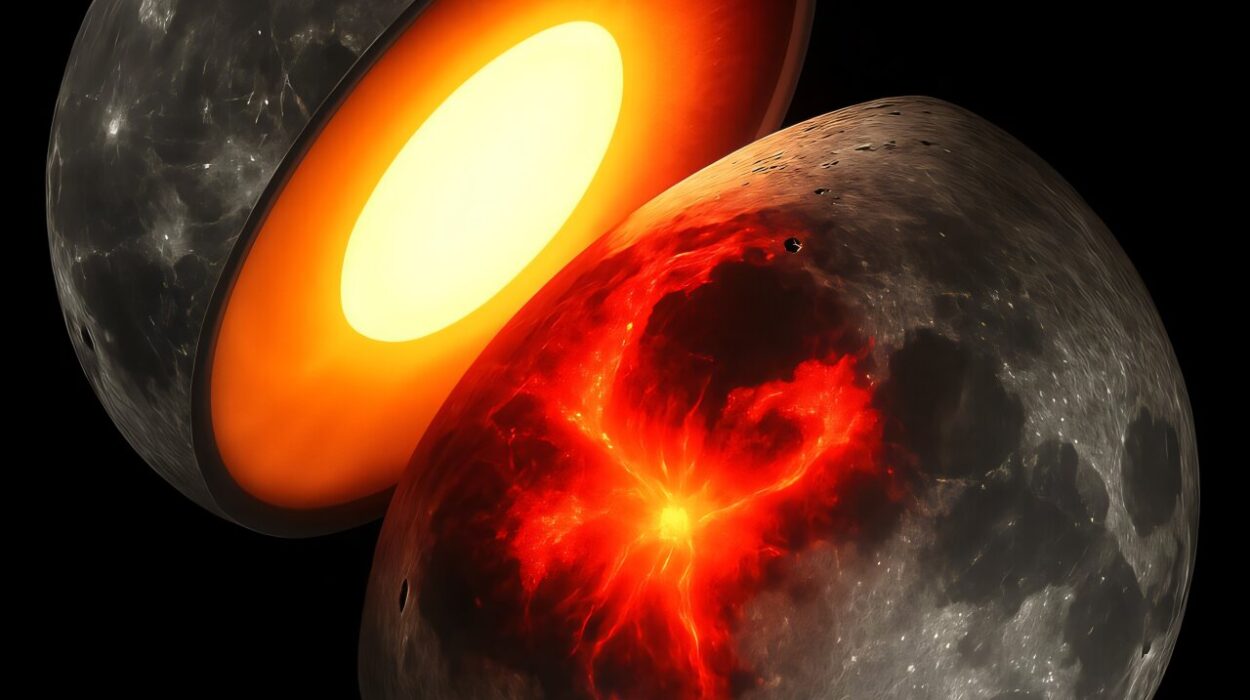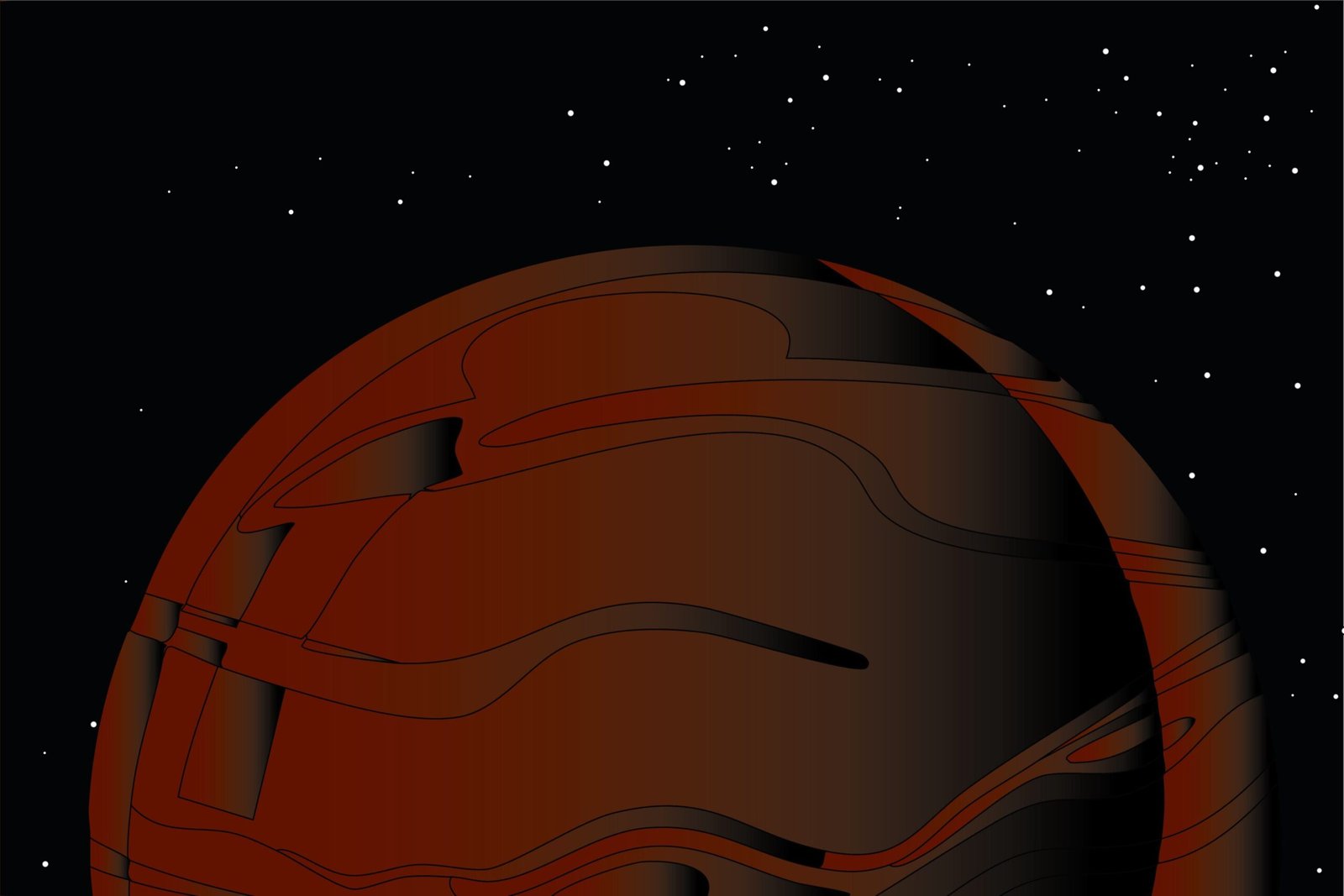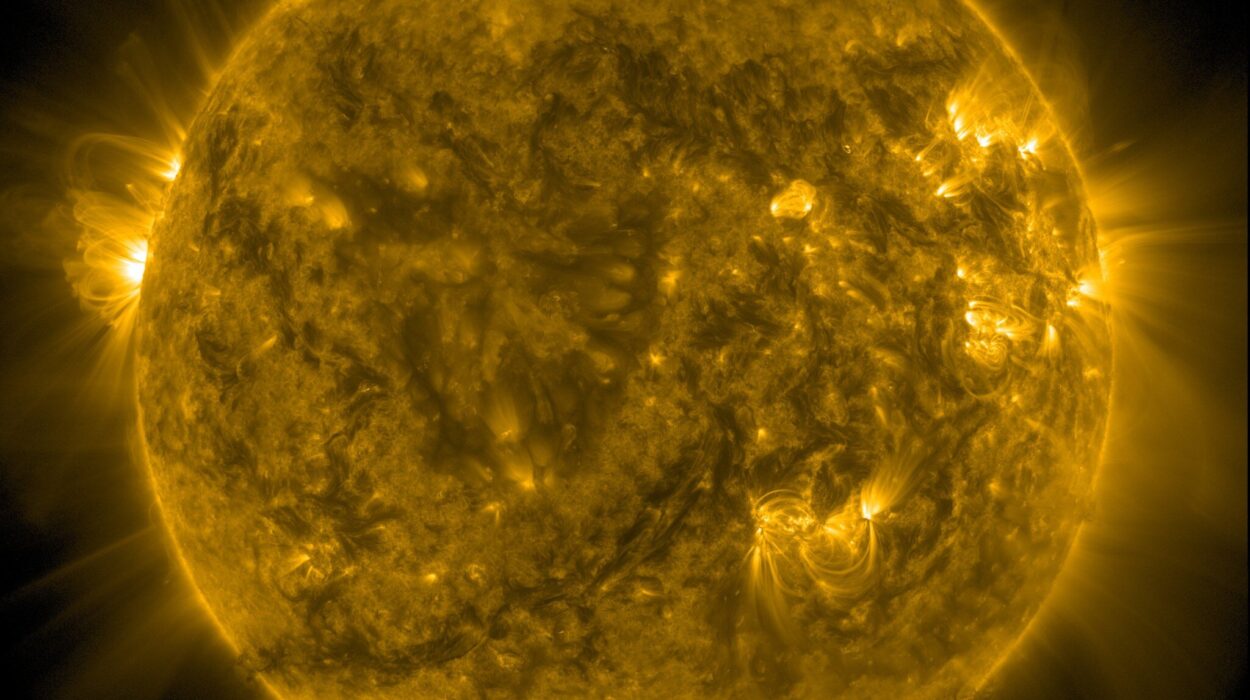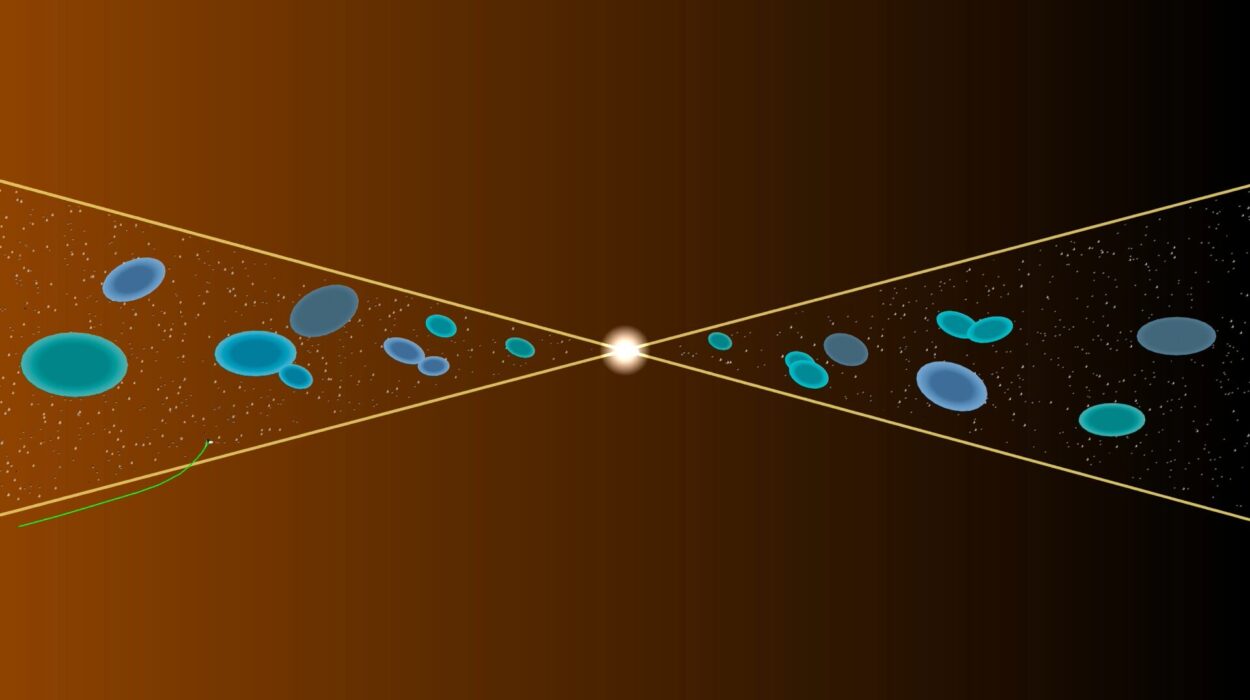In the vast, ancient reaches of the universe—over eight billion light-years away—a galaxy is being torn apart. Not by violence alone, but by a silent force that strips its gas and leaves in its wake a spectacular cosmic tail of light and life. Thanks to the James Webb Space Telescope’s piercing vision, scientists have discovered one of the earliest examples yet of a rare galactic phenomenon known as a “jellyfish galaxy.”
The newly identified galaxy, known as COSMOS2020-635829, is no ordinary collection of stars. Unveiled in a study posted June 17 to the arXiv preprint server by an international team of astronomers from Canada and Switzerland, this ancient object is leaving behind more than just a trail of gas. It’s painting a vivid picture of how galaxies once lived—and how they died—in the turbulent youth of the universe.
“We report the discovery of COSMOS2020-635829 as a likely jellyfish galaxy undergoing ram pressure stripping in a (proto)cluster at z > 1,” wrote lead author Ian D. Roberts of the University of Waterloo. That “z > 1” means the light we’re seeing left the galaxy when the universe was less than half its current age—an era known as Cosmic Noon, when galaxies were at the peak of their star-forming frenzy.
What Is a Jellyfish Galaxy?
Imagine a galaxy cruising through space, like a boat plowing through water. Now imagine that water is thick with gas, and as the galaxy moves, it leaves behind swirling eddies of stripped material. This is ram pressure stripping, and it’s how jellyfish galaxies are born.
Named for their resemblance to their aquatic namesakes, jellyfish galaxies exhibit long, trailing arms made of gas and young stars that stretch from one side of the galactic disk. These shimmering appendages aren’t just beautiful—they’re snapshots of physical processes that can shape, or even end, a galaxy’s ability to form stars.
COSMOS2020-635829 is among the most distant examples of this phenomenon ever discovered. And what makes it truly astonishing is that its ghostly trail of blue knots—the birthplaces of new stars—is not just visible, but clear. The James Webb Space Telescope’s unmatched resolution has revealed a perfectly symmetrical disk of older stars, offset by a one-sided tail of vibrant, youthful star clusters. This isn’t just a jellyfish galaxy—it’s a textbook case, frozen in cosmic time.
A Tail of Starry Knots
The team’s observations suggest that the tail extending from COSMOS2020-635829 is more than just stripped gas—it’s alive with new stars. These star-forming knots, scattered like cosmic pearls along the ionized gas trail, have individual masses of about 100 million suns. They’re not just glowing—they’re growing.
Each knot produces new stars at a modest but steady pace of roughly 0.1 to 1 solar mass per year. That may not sound like much, but collectively, they account for a full one percent of the entire galaxy’s stellar mass. For a galaxy with a total mass of roughly 10 billion solar masses, that’s no small contribution from structures that didn’t even exist before the stripping began.
But where exactly is COSMOS2020-635829 in this great cosmic dance? The galaxy resides in a cluster-mass, X-ray bright overdensity—a kind of gravitational beehive, where thousands of galaxies orbit through clouds of hot gas. As COSMOS2020-635829 moves through this high-density region, it encounters an invisible headwind—the intracluster medium—that strips gas from its core.
The process is violent, but paradoxically, it also creates new life. As the gas is torn away, it’s compressed, triggering bursts of star formation in the stripped material. It’s as if the galaxy is shedding skin and growing stars all at once.
The Cosmic Clock Is Ticking
COSMOS2020-635829’s redshift of 1.156 places it at a time when the universe was just under five billion years old. For astronomers, that makes this galaxy a time capsule. It is the highest redshift jellyfish galaxy ever found with evidence of ionized gas tails and extra-planar star formation—a mouthful, but a critical discovery. It tells us that galaxies have been experiencing environmental forces like ram pressure stripping for a very long time, and that these forces may have played a key role in how galaxies aged, slowed down, and ultimately faded into quiet retirement.
“This work reinforces the notion that ram pressure stripping can perturb group and cluster galaxies at z > 1,” the authors write, “and likely contributes to environmental quenching even near Cosmic Noon.”
Quenching is the term astronomers use when a galaxy stops forming new stars. It’s a mystery with many suspects: black holes, mergers, supernovae—but now, thanks to galaxies like COSMOS2020-635829, ram pressure stripping is stepping into the spotlight as a potentially major player.
Why It Matters
Modern telescopes have transformed our understanding of the universe, but discoveries like this are about more than just seeing farther. They’re about understanding how the universe builds and breaks its own creations. Jellyfish galaxies like COSMOS2020-635829 aren’t just strange outliers—they’re crucial laboratories for testing how galaxies lose their gas, and therefore their ability to birth stars.
In today’s universe, jellyfish galaxies are rare and often tucked away in massive clusters. But the presence of one so far back in time suggests that these dramatic transformations have been occurring far longer than we thought—and perhaps were more common during the universe’s most prolific years.
With the James Webb Space Telescope, astronomers are not only catching glimpses of galaxies at their brightest—they’re witnessing their most vulnerable moments. As these ancient systems are shaped by invisible forces, torn apart by their cosmic environments, and lit up by the sparks of rebirth, we are reminded that the universe is both destroyer and creator—and sometimes, at the same time.
A Glowing Beacon in the Deep Past
COSMOS2020-635829 may be just one galaxy among billions, but it offers something rare: a direct window into the pressures that sculpted early galaxies, a cosmic fossil shaped by movement and light. Its brilliant tail of stars shines like a beacon across time, whispering stories of galactic hardship, adaptation, and change.
As researchers continue to survey the distant universe with Webb’s incredible eye, we can expect more discoveries like this—each one a piece of the larger puzzle of where we came from and how the grand machinery of the cosmos works.
In the words of the scientists, it’s a vivid reminder that the way the universe works now is not how it always was. And in the fleeting glow of a jellyfish galaxy, we catch a glimpse of evolution in real time—set against the dark, endless backdrop of the early universe.
Reference: Ian D. Roberts et al, JWST Reveals a Likely Jellyfish Galaxy at z=1.156, arXiv (2025). DOI: 10.48550/arxiv.2506.14117
